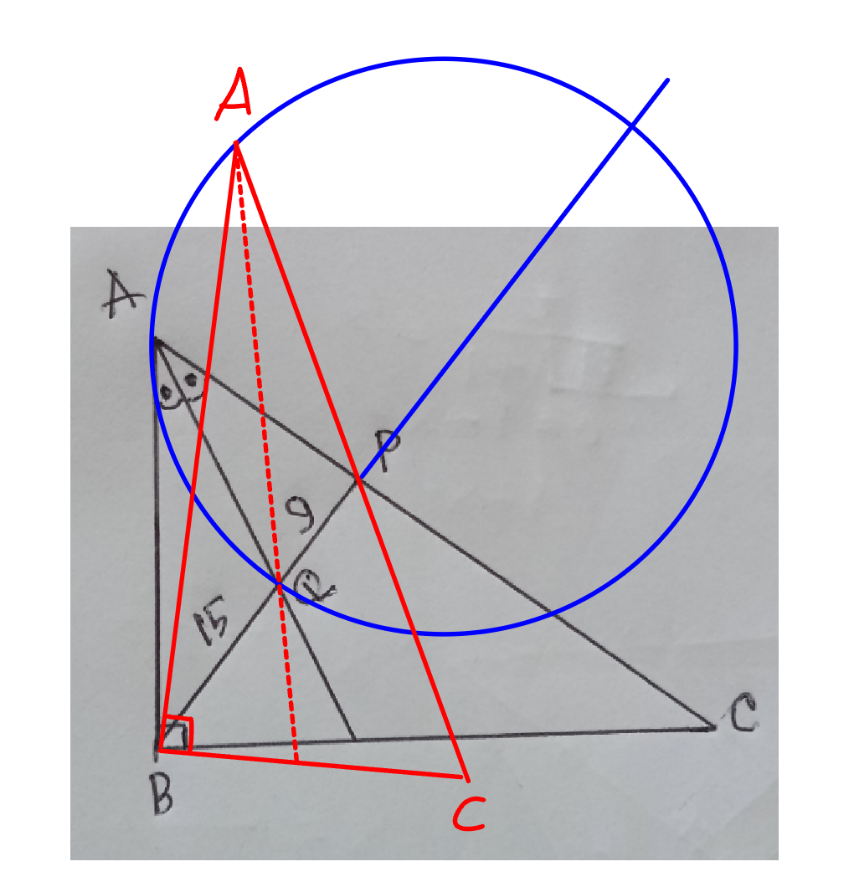
Question Number 206157 by cortano21 last updated on 08/Apr/24
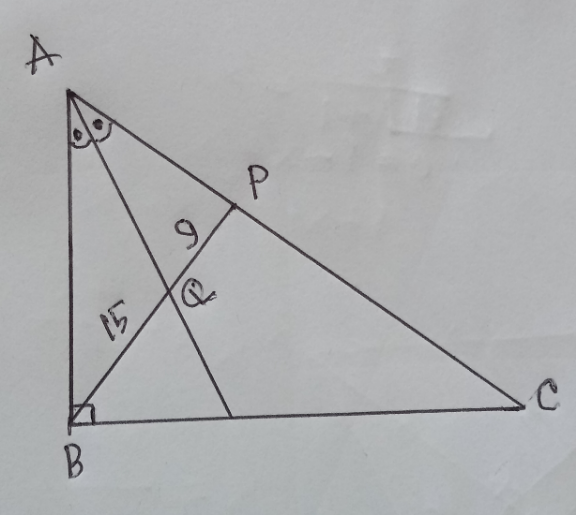
Commented by cortano21 last updated on 08/Apr/24

$$\:\:\:\: \bigtriangleup \\ $$
Commented by A5T last updated on 09/Apr/24

$${This}\:{is}\:{generally}\:{not}\:{uniquely}\:{defined}.\:{One}\:{can} \\ $$$${come}\:{up}\:{with}\:{mathematically}\:{correct}\:{solutions} \\ $$$${with}\:{different}\:{answers}.\:{Points}\:{A}\:{such}\:{that}\: \\ $$$$\frac{{AB}}{{AP}}=\frac{\mathrm{5}}{\mathrm{3}}\:{lie}\:{on}\:{the}\:{Apollonius}\:{circle}. \\ $$
Commented by A5T last updated on 09/Apr/24

Answered by dimentri last updated on 08/Apr/24
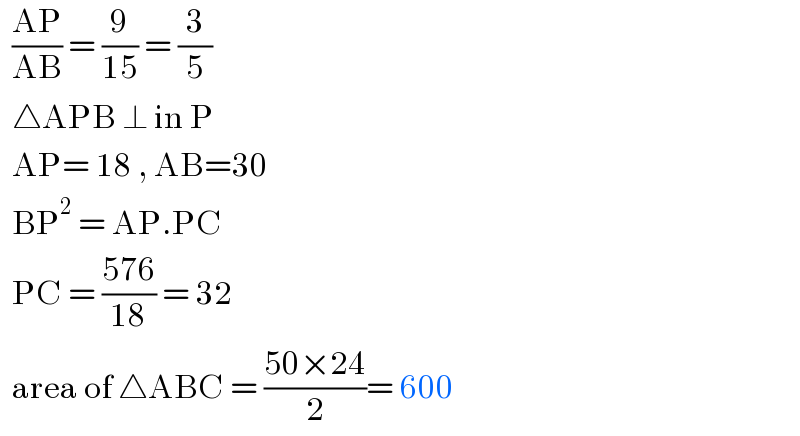
$$\:\:\frac{\mathrm{AP}}{\mathrm{AB}}\:=\:\frac{\mathrm{9}}{\mathrm{15}}\:=\:\frac{\mathrm{3}}{\mathrm{5}} \\ $$$$\:\:\bigtriangleup\mathrm{APB}\:\bot\:\mathrm{in}\:\mathrm{P} \\ $$$$\:\:\mathrm{AP}=\:\mathrm{18}\:,\:\mathrm{AB}=\mathrm{30} \\ $$$$\:\:\mathrm{BP}^{\mathrm{2}} \:=\:\mathrm{AP}.\mathrm{PC}\: \\ $$$$\:\:\mathrm{PC}\:=\:\frac{\mathrm{576}}{\mathrm{18}}\:=\:\mathrm{32} \\ $$$$\:\:\mathrm{area}\:\mathrm{of}\:\bigtriangleup\mathrm{ABC}\:=\:\frac{\mathrm{50}×\mathrm{24}}{\mathrm{2}}=\:\mathrm{600} \\ $$
Commented by mr W last updated on 08/Apr/24

$${i}\:{think}\:{it}\:{is}\:{not}\:{said}\:{that}\:{AP}\bot{BC}. \\ $$
Answered by mr W last updated on 08/Apr/24
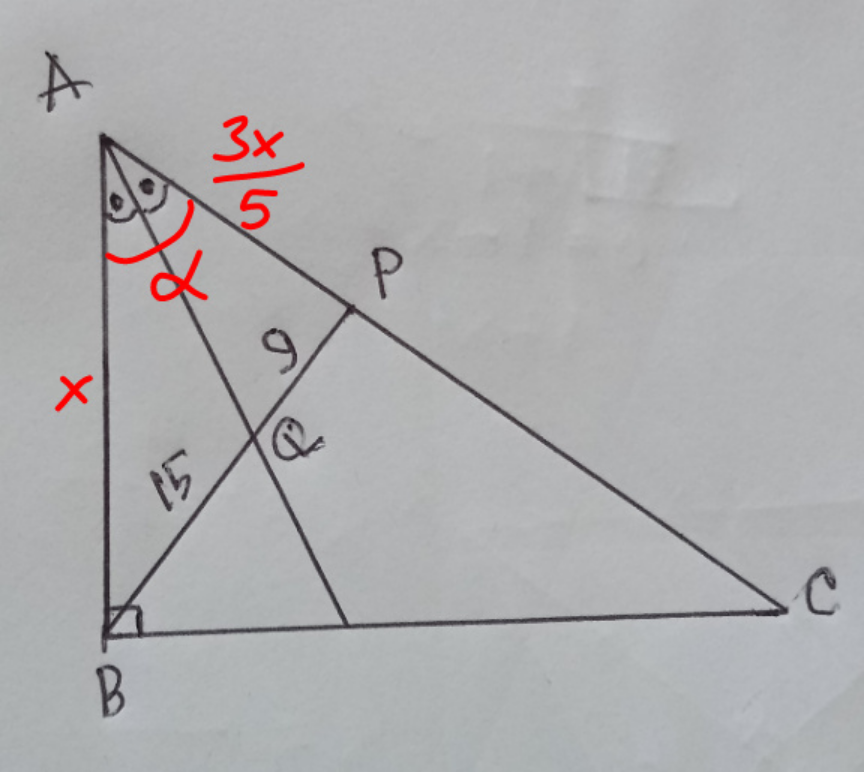
Commented by mr W last updated on 09/Apr/24
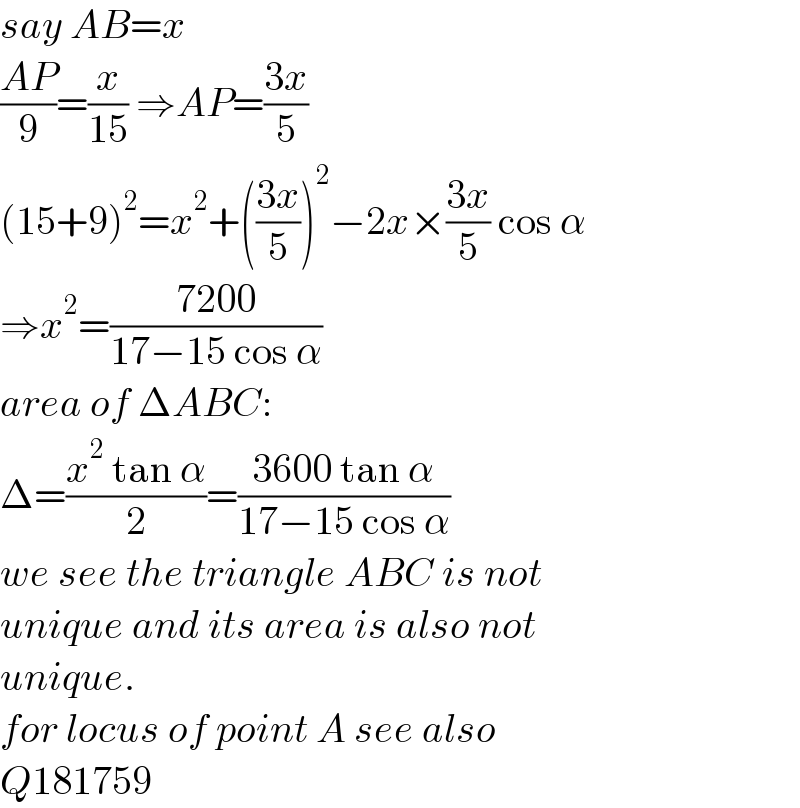
$${say}\:{AB}={x} \\ $$$$\frac{{AP}}{\mathrm{9}}=\frac{{x}}{\mathrm{15}}\:\Rightarrow{AP}=\frac{\mathrm{3}{x}}{\mathrm{5}} \\ $$$$\left(\mathrm{15}+\mathrm{9}\right)^{\mathrm{2}} ={x}^{\mathrm{2}} +\left(\frac{\mathrm{3}{x}}{\mathrm{5}}\right)^{\mathrm{2}} −\mathrm{2}{x}×\frac{\mathrm{3}{x}}{\mathrm{5}}\:\mathrm{cos}\:\alpha \\ $$$$\Rightarrow{x}^{\mathrm{2}} =\frac{\mathrm{7200}}{\mathrm{17}−\mathrm{15}\:\mathrm{cos}\:\alpha} \\ $$$${area}\:{of}\:\Delta{ABC}: \\ $$$$\Delta=\frac{{x}^{\mathrm{2}} \:\mathrm{tan}\:\alpha}{\mathrm{2}}=\frac{\mathrm{3600}\:\mathrm{tan}\:\alpha}{\mathrm{17}−\mathrm{15}\:\mathrm{cos}\:\alpha} \\ $$$${we}\:{see}\:{the}\:{triangle}\:{ABC}\:{is}\:{not} \\ $$$${unique}\:{and}\:{its}\:{area}\:{is}\:{also}\:{not} \\ $$$${unique}. \\ $$$${for}\:{locus}\:{of}\:{point}\:{A}\:{see}\:{also} \\ $$$${Q}\mathrm{181759} \\ $$
Commented by mr W last updated on 08/Apr/24
